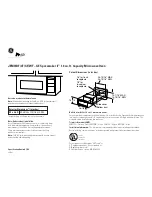
Section 3 Troubleshooting and Testing
3-4
Procedure
Letter
B
C
Component Test
POWER TRANSFORMER TEST
1. Disconnect the power supply cord, and then remove outer case.
2. Open the door and block it open.
3. Discharge high voltage capacitor. (See Warnings and Instructions on page 3-1)
4. Disconnect the primary input terminals and measure the resistance of the transformer with an
ohmmeter. Check for continuity of the coils with an ohmmeter. On R x 1 scale, the resistance of
the primary coil should be less than 1 ohm and the resistance of the high voltage coil should be
approximately 83 ohms; the resistance of filament coil should be less than 1 ohm.
5. Reconnect all leads removed from components during testing.
6. Reinstall the outer case (cabinet).
7. Reconnect the power supply cord after the outer case is installed.
8. Run the oven and check all functions.
HIGH VOLTAGE RECTIFIER TEST
1. Disconnect the power supply cord, and then remove outer case.
2. Open the door and block it open.
3. Discharge high voltage capacitor. (See Warnings and Instructions on page 3-1)
4. Isolate the rectifier from the circuit. Using the highest ohm scale of the meter, read the
resistance across the terminals and observe, reverse the leads to the rectifier terminals and
observe meter reading. If a short is indicated in both directions, or if an infinite resistance is
read in both directions, the rectifier is probably defective and should be replaced.
5. Reconnect all leads removed from components during testing.
6. Reinstall the outer case (cabinet).
7. Reconnect the power supply cord after the outer case is installed.
8. Run the oven and check all functions.
Do not touch the components of the power transformer while power transformer is
energized. It is dangerous because this has high voltage components. (High voltages
are present at the high voltage terminal, so do not attempt to measure the
f
lament
and high voltage.)
WARNING
NOTE
To properly test the rectifier a meter with a 9 volt power supply is needed.
















































